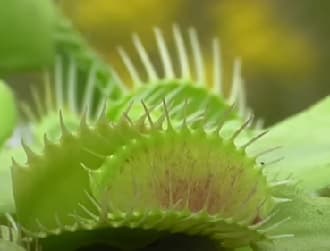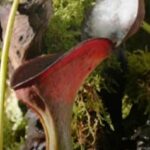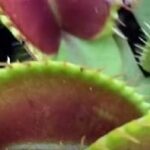As an Amazon Associate, this site earns commissions from qualifying purchases. For more details, click here.
Watching a Venus flytrap lure, trap and eat a bug never gets old. You have probably seen these online and in person too. It’s endlessly fascinating but the question is why? Is it necessary for their survival?
Most plants get nutrients from the soil. Venus flytraps however, only grow in poor soil, so they eat insects that have the nutrients they require.
Can Venus Flytraps Live without Eating Bugs?
Venus flytraps can survive for long periods without eating bugs. If the plant gets plenty of light and water, it can live without eating insects at all. It won’t thrive or reach its maximum growth potential, but it will live.
Contrary to popular belief, Venus flytraps do not need insects for energy or food. They require insects for their nutrients.
The words “energy”, “food’ and “nutrients” are used interchangeably but there are differences.
Like all plants, Venus flytraps use photosynthesis to make their own food. Plants do not eat food the way humans do, but it provides essential energy.
Venus flytraps use this energy for their growth, boost their immune system and create traps.
Most plants require nutrient-rich soil for maintenance and boost their energy and growth potential.
Venus flytraps and other carnivorous plants however, only grow in poor soil. If you plant a Venus flytrap in rich soil it will slowly die. Because Venus flytraps still need those nutrients, they turned to insects.
How Venus Flytraps Eat Insects
Venus flytraps produce a fruity scent to lure insects. Once a prey lands on the plant, the trap is set.
When an insect falls into the trap, it triggers the Venus flytrap’s sensors, the filaments you see on its leaves. The trap shuts and the more the bug struggles to get out, the tighter the trap gets.
The plant releases enzymes that breaks the insect’s tissues down. If the insect has not died from suffocation, the enzymes will kill it.
Once the tissues are dissolved, the plant absorbs it along with the digestive enzymes. When a Venus flytrap is done feeding, the trap will reopen, ready to catch another prey.
How the Traps Work
Venus flytraps have a sophisticated mechanism that can distinguish between bugs and inanimate objects.
Venus flytraps have sensors that get triggered when something falls in the trap. But the trap will only close when these sensors are set off multiple times. That is how it can tell the difference between prey and inanimate objects.
If debris fall in the trap, it will set off the triggers just once. The trap won’t close.
If a small bug lands on the trap, it is going to move around the trap, setting off the hairs again and again. This tells a Venus flytrap it is probably prey and will shut the trap.
Venus flytraps wait until the sensors have been triggered 2-3 times in intervals of 20-30 seconds before closing. So yes, Venus flytraps know how to count.
It is a simple but effective mechanism. It saves the trap’s energy so it doesn’t get wasted on debris. How Venus flytraps developed this is still subject to research.
What Insects Do Venus Flytraps Eat?
Venus flytraps eat flies, spiders, beetles, grasshoppers, and other small flying insects. These plants also consume ants and other crawling bugs.
Venus flytraps can only eat small bugs. By that I mean only one third the size of its trap. A typical trap is 1-1.5 inches long, so its diet is limited to tiny insects.
You’ve probably seen videos of Venus flytraps trapping large bugs. The truth is that consuming a large prey could kill the trap. If it is too big, the trap will exhaust all its resources trying to digest it.
Some Venus flytraps grow to large sizes, but most are small and do not need to eat a lot.
In general, Venus flytraps will eat any animal that falls into its trap. Even if it is too large for the trap, the digestive process is automatic.. If its sensors are set off several times, it will try to close the trap.
An adult cockroach is usually 1-2 inches long, too big for a Venus flytrap. But if it crawls in and triggers the hairs, the plant will try to hold it down.
Large bugs, worms and other creatures can get out a Venus flytrap. They will rip the leaves or eat their way out.
Do Venus Flytraps Eat Pollinators?
Short answer is no, they do not. The structure of a Venus flytrap makes its pollinators like bees safe.
If you let Venus flytraps flower, one of the things you will notice is that its flowers sprout higher than the traps.
There’s a good reason for this, and that is to keep pollinators away from the traps. Since the flowers are atop the long stem, pollinators are kept out of harm’s way.
There could be other reasons as well. Some scientists believe that pollinators might be more attracted to the flowers’ color rather than the trap.
It is also possible Venus flytraps release scents that lure pollinators to the flowers instead of the traps.
It’s been established that Venus flytraps produce a fruity scent to lure bugs, so it’s possible they do the same with pollinators.
Does this mean that Venus flytraps “know” the difference between a pollinator and prey?
Not exactly. If a bee wanders off and falls into the trap, the plant will eat it. This does happen from time to time and proves that Venus flytraps will consume pollinators if it lands in the trap.

How Often Do Venus Flytraps Eat?
Venus flytraps eat once a week or every two weeks. You only need to feed it if indoors. If the plant is outdoors, it will catch bugs on its own.
Don’t overfeed Venus flytraps because it can kill the trap. If your Venus flytrap is turning black, this is one of the possible reasons.
It takes Venus flytraps 5-7 days to digest food, sometimes longer. The larger the food, the longer the digestive process.
It’s fun to watch Venus flytraps eat, but you should avoid overfeeding. If you keep the plant outside it should have no problems luring bugs to the traps.
If you are going to hand feed Venus flytraps, do so once a week or every two weeks. If you see one of its traps closed, it means the plant is digesting food.
Wait for all traps to open before feeding it. I would recommend Orchid Gene as it is suitable for Venus flytraps.
Related Questions
Can Venus flytraps eat dead insects?
Venus flytraps will eat dead bugs, but it needs help. Unless you trigger its sensors, the trap will not close over a lifeless bug.
If you want to feed it dead bugs or freeze dried mealworms , use a brush to stimulate it. Once the trap starts moving, digestion will proceed.
How many insects can a Venus flytrap eat?
Most Venus flytraps eat one insect at a time. Sometimes you might see two traps closed, but usually it’s just one.
Eating bugs is an energy intensive process. Venus flytraps go through it because they receive nutrients. But too many simultaneous meals isn’t good for the plant.
Why is my Venus flytrap not eating?
There are two possible reasons: the plant is sick or going dormant.
Venus flytraps enter dormancy during winter. During this time it’s normal for the plant to stop eating. Venus flytraps look sick when dormant, but it’s part of their life cycle and will reemerge in the spring.
Venus flytraps that refuse to eat during growth season are in poor health. This is usually due to lack of light, water, infestation or stress due to its environment.
Why is my Venus flytrap not eating the food in its trap?
Venus flytraps take a long time to digest food, up to two weeks in some cases. This is normal especially if the food is large or the plant had just recently eaten.

My fascination with carnivorous plants began many, many years ago with Venus Fly Traps. Now I am more than happy to impart what I know with other enthusiasts and those who are curious about meat eating plants.


